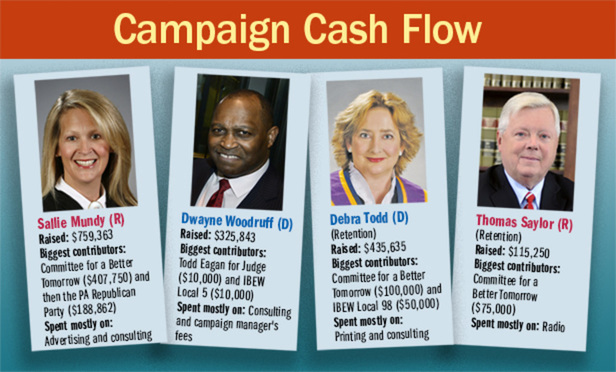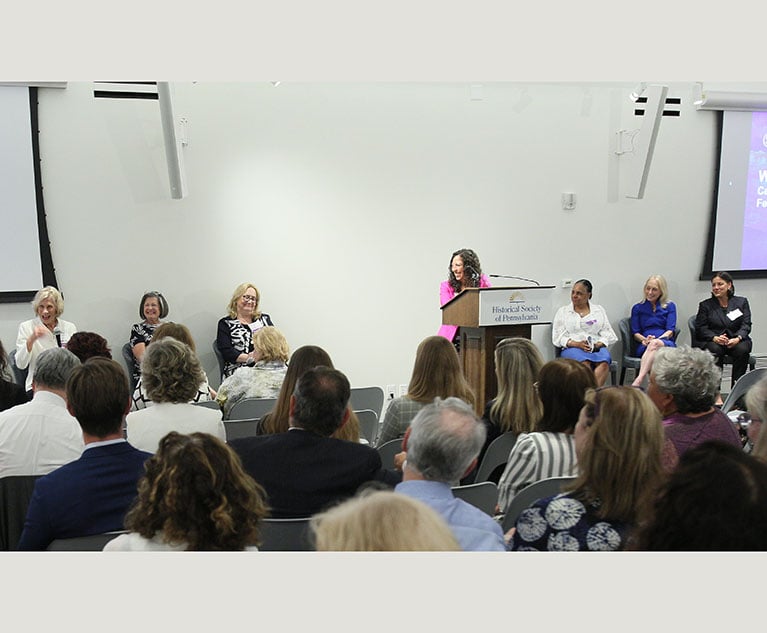Trial Lawyers Spent Big Bucks on 2017 Pa. Supreme Court Incumbents
A group of Philadelphia trial lawyers has spent the most money out of any single donor to keep their favorite justices on the Pennsylvania Supreme Court bench this election year.
November 03, 2017 at 05:35 PM
6 minute read

A group of Philadelphia trial lawyers has spent the most money out of any single donor to keep their favorite justices on the Pennsylvania Supreme Court bench this election year.
The Committee for a Better Tomorrow, the PAC for the Philadelphia Trial Lawyers Association, shelled out over a half-a-million dollars total to three out of four Supreme Court candidates this year, according to the most up-to-date campaign finance reports.
Interim Justice Sallie Updyke Mundy, a Republican who is competing against Allegheny County trial judge and former Pittsburgh Steelers MVP cornerback Dwayne D. Woodruff, a Democrat, for an open seat on the court, received more than $400,000 from the committee. The committee was the single biggest contributor to the retention campaigns of both Republican Chief Justice Thomas G. Saylor and Justice Debra Todd, a Democrat, giving $75,000 to Saylor and $100,000 to Todd.
The Committee for a Better Tomorrow supports candidates who “believe in the civil justice system, trial by jury, and tort recovery” as well as “candidates who share our values,” according to the Philadelphia Trial Lawyers Association website. The association's annual president is almost always a prominent Philadelphia personal injury lawyer.
Larry Cohan, a medical malpractice lawyer, is the chairman of the Committee for a Better Tomorrow and said the committee put its support behind the sitting justices because of their understanding of the importance of civil justice.
“Justices Todd and Saylor have demonstrated that they are exceptional jurists and that they understand the right of the individual to have access to the civil justice system,” Cohan said, adding, “Justice Mundy … has also demonstrated a similar, long track record and understanding of the civil justice system and the need to have access to that system.”
Other groups, mostly trade unions and law firms, also contributed significantly to the individual campaigns. In Mundy's case, her second-biggest contributor was the Pennsylvania Republican Party, which donated roughly $189,000 to her campaign. She also received $25,000 from state Sen. Joseph Scarnati's PAC and another $25,000 from the Build PA PAC.
Woodruff's biggest contributors were Todd Eagen for Judge, the PAC of lawyer and former Commonwealth Court candidate Todd Eagen, which gave $10,000; the International Brotherhood of Electrical Workers, Local 5 in Pittsburgh, which gave $10,000; and Steelers owner Arthur Rooney II, who also gave $10,000.
Todd received $50,000 from IBEW Local 98, run by prominent Philadelphia union boss John Dougherty, whose brother, Kevin Dougherty, also sits on the Supreme Court. Saylor had little union support but did receive several thousand-dollar donations from individual lawyers.
Each candidate raised six-figure amounts: Mundy raised approximately $759,363; Woodruff raised $325,843; Todd raised $435,635; and Saylor trailed the pack with $115,250. The candidates spent mostly on advertising and consulting.
Todd's campaign treasurer, Stephen K. Todd, declined to comment on his wife's campaign finances. Saylor's campaign treasurer, Robert J. Murphy, did not return a call seeking comment.
Image Is Everything
The last state Supreme Court election, in 2015, saw more televised ads than any other time in state history—and record spending of $14 million total—but even though spending has not reached those same heights this year, television ads are still playing a big part in the current judicial election cycle.
As Nov. 7 draws near, candidates from common pleas court to the Supreme Court have ramped up their TV presence with ads popping up seemingly during every commercial break.
The tactic makes sense, given that most Pennsylvania voters don't know who is running or what the different state courts even do. In the absence of TV ads, judicial candidates have to rely heavily on ballot position, along with the usual handouts and lawn signs—often lost in a forest of similar materials from other candidates—to get their names out.
While ex-Steeler Woodruff has been relatively scarce on the airwaves, Mundy has been ubiquitous on the small screen.
“That's the only way you can reach the people,” said her husband and campaign treasurer, James Mundy.
Justice Mundy tailors her 15-second TV spots to each region where they air. In the ad that runs in the Pittsburgh area, she mentions that she's a proud University of Pittsburgh grad. The midstate voters learn that she worked for a law firm in Centre County. And in the Philadelphia market, she tells viewers that she practiced law in the city for a decade.
Mundy's husband said those ads don't come cheap, though he couldn't give a specific figure, and noted that Philadelphia was the most expensive.
“We've spent every penny,” he said.
Increasing advertising during the last few weeks of a judicial election is typical, with the goal being to capitalize on a viewer's attention span and the close proximity to the race.
G. Terry Madonna, a pollster and director of the Center for Politics and Public Affairs at Franklin & Marshall College, said that it was unusual not to see a popular sports personality like Woodruff taking advantage of television ads, although he noted that Mundy far out-earned him.
“That's unusual because in 2015 the Democrats outspent the Republicans three to one,” when the political makeup of the court was at stake, Madonna said. The then-majority Republican Court flipped with the election of three democrats: David Wecht, Kevin Dougherty and Christine Donohue.
Madonna did note that Woodruff could decide to “dump a small fortune” in the short time left before Election Day. Woodruff's campaign treasurer, Edwin Edwards, deferred comment to Teresa Lundy, a spokesperson at the political consulting company, TML Communications LLC.
Lundy said that Woodruff is banking heavily on name recognition but also has a shared TV presence in commercials with other Democratic judicial candidates for the Commonwealth and Superior courts, jointly referred to as the “Slate of Eight.”
Woodruff's campaign has also invested heavily in print and radio ads.
“We are strategically putting our money where it needs to be,” Lundy said.
This content has been archived. It is available through our partners, LexisNexis® and Bloomberg Law.
To view this content, please continue to their sites.
Not a Lexis Subscriber?
Subscribe Now
Not a Bloomberg Law Subscriber?
Subscribe Now
NOT FOR REPRINT
© 2025 ALM Global, LLC, All Rights Reserved. Request academic re-use from www.copyright.com. All other uses, submit a request to [email protected]. For more information visit Asset & Logo Licensing.
You Might Like
View All

Phila. Med Mal Lawyers In for Busy Year as Court Adjusts for Filing Boom
3 minute read
'Recover, Reflect, Retool and Retry': Lessons From Women Atop Pa. Legal Community
3 minute read
EDPA's New Chief Judge Plans to Advance Efforts to Combat Threats to Judiciary
3 minute readTrending Stories
- 1Thursday Newspaper
- 2Public Notices/Calendars
- 3Judicial Ethics Opinion 24-117
- 4Rejuvenation of a Sharp Employer Non-Compete Tool: Delaware Supreme Court Reinvigorates the Employee Choice Doctrine
- 5Mastering Litigation in New York’s Commercial Division Part V, Leave It to the Experts: Expert Discovery in the New York Commercial Division
Who Got The Work
J. Brugh Lower of Gibbons has entered an appearance for industrial equipment supplier Devco Corporation in a pending trademark infringement lawsuit. The suit, accusing the defendant of selling knock-off Graco products, was filed Dec. 18 in New Jersey District Court by Rivkin Radler on behalf of Graco Inc. and Graco Minnesota. The case, assigned to U.S. District Judge Zahid N. Quraishi, is 3:24-cv-11294, Graco Inc. et al v. Devco Corporation.
Who Got The Work
Rebecca Maller-Stein and Kent A. Yalowitz of Arnold & Porter Kaye Scholer have entered their appearances for Hanaco Venture Capital and its executives, Lior Prosor and David Frankel, in a pending securities lawsuit. The action, filed on Dec. 24 in New York Southern District Court by Zell, Aron & Co. on behalf of Goldeneye Advisors, accuses the defendants of negligently and fraudulently managing the plaintiff's $1 million investment. The case, assigned to U.S. District Judge Vernon S. Broderick, is 1:24-cv-09918, Goldeneye Advisors, LLC v. Hanaco Venture Capital, Ltd. et al.
Who Got The Work
Attorneys from A&O Shearman has stepped in as defense counsel for Toronto-Dominion Bank and other defendants in a pending securities class action. The suit, filed Dec. 11 in New York Southern District Court by Bleichmar Fonti & Auld, accuses the defendants of concealing the bank's 'pervasive' deficiencies in regards to its compliance with the Bank Secrecy Act and the quality of its anti-money laundering controls. The case, assigned to U.S. District Judge Arun Subramanian, is 1:24-cv-09445, Gonzalez v. The Toronto-Dominion Bank et al.
Who Got The Work
Crown Castle International, a Pennsylvania company providing shared communications infrastructure, has turned to Luke D. Wolf of Gordon Rees Scully Mansukhani to fend off a pending breach-of-contract lawsuit. The court action, filed Nov. 25 in Michigan Eastern District Court by Hooper Hathaway PC on behalf of The Town Residences LLC, accuses Crown Castle of failing to transfer approximately $30,000 in utility payments from T-Mobile in breach of a roof-top lease and assignment agreement. The case, assigned to U.S. District Judge Susan K. Declercq, is 2:24-cv-13131, The Town Residences LLC v. T-Mobile US, Inc. et al.
Who Got The Work
Wilfred P. Coronato and Daniel M. Schwartz of McCarter & English have stepped in as defense counsel to Electrolux Home Products Inc. in a pending product liability lawsuit. The court action, filed Nov. 26 in New York Eastern District Court by Poulos Lopiccolo PC and Nagel Rice LLP on behalf of David Stern, alleges that the defendant's refrigerators’ drawers and shelving repeatedly break and fall apart within months after purchase. The case, assigned to U.S. District Judge Joan M. Azrack, is 2:24-cv-08204, Stern v. Electrolux Home Products, Inc.
Featured Firms
Law Offices of Gary Martin Hays & Associates, P.C.
(470) 294-1674
Law Offices of Mark E. Salomone
(857) 444-6468
Smith & Hassler
(713) 739-1250





